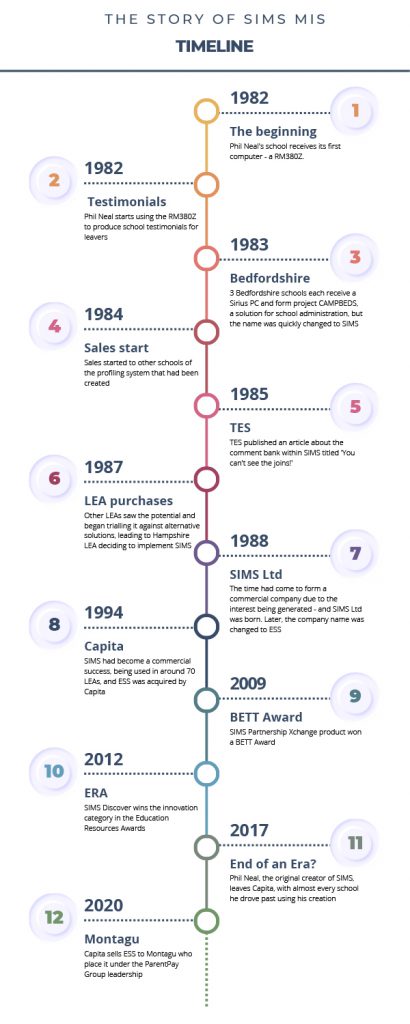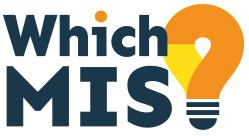The Birth of the UK MIS
Phil Neal, the original creator of SIMS, reminisces about the product’s origins and some of the challenges he was faced with along the way.
In the early 80s the government introduced computing to the curriculum and provided my school with its first computer, the RM 380Z. It came with the Basic programming language and WordStar, a program that converted a computer into a word processor which until then had been a dedicated machine.
When the 380Z wasn’t in classroom use, Dave Wood saw the potential to use it to manage exam entries and I saw the possibility of using it to produce school testimonials for our leavers.
Producing testimonials was a mammoth task that occupied teacher time in writing them and even more administrative effort in typing them out. I studied hundreds of competed testimonials and concluded that tutors repeated multiple phrases across different students and the idea of using comment banks was born.

We extended this to producing school reports and although some staff felt that this was impersonal, I felt the resulting reports were far more specific and required much better knowledge of the pupils’ abilities in order to complete them. The key was to ensure that the available comments didn’t say “satisfactory” in 100 words.
I wrote a Basic programme that created comma delimited files containing student names and codes for the required phrases. These files were then fed into WordStar which formatted the final output. Printing was onto continuous paper which then had to be guillotined to the correct size but a year group would take an entire weekend and I would need go into the school several times and change the box of paper.
Interest in school administration by computer was growing. A Scottish system, SCAMP, was being trialled in a number of English & Welsh LEAs but it used mini-computers which were well beyond the budgets of most schools. In Bedfordshire where my school was located, John Warwick, the Maths advisor formed a working group to define schools’ requirements for an administration system. The plan was to create a Bedfordshire solution and three schools were selected to receive a Sirius PC. We called the project CAMPBEDS! (Computer Aided Management Programme Bedfordshire) –but that name got replaced by SIMS (School Information Management System) when Andy Rayment was seconded to implement the system in Bedfordshire schools.
The expectation was that the LA IT department would create a solution for schools however that didn’t happen, and in my own time I began to write the admin systems that would manage pupil records using dBase II. I needed this to manage the production of our school reports.
After this was done there were some quick wins:
- the rolodex student card system maintained by the office staff could quickly be updated. This had to be printed out as there was still only one computer in the school;
- the census could be produced very easily although it took some persuasion to get the Education Department to accept computer generated forms;
- the monthly student movement report that the LEA required could be produced easily;
- the school roll book could easily be produced although convincing the authority to move away from a handwritten book was not easy.
The Basic exam entry system had to be reworked into dBase and then we turned our attention to attendance recording. The system relied on Optical Mark Readers as classroom teachers did not have access to PCs. Again, the time savings were considerable as previously the clerical staff would do a daily trawl of registers to find absent students and call their homes. When it came to end of year reporting, the system was able to supply teachers with accurate attendance figures which previously had to be counted by them manually.

Other LEAs began trialling SIMS against alternative solutions. SCAMP was the dominant solution but there were many others from LEAs and entrepreneurs. I can still remember the call confirming that Hampshire wanted to implement SIMS – I was astonished & elated! At this time, I was still working on SIMS in my own time but when the first support call came through my boss decided that I either had to give up SIMS or move to it full time.
We then tackled assessment recording which again had to be performed using OMR sheets. However, what really accelerated the uptake of SIMS was the government introducing local management of schools; until then the LEA had micromanaged schools. We saw the need for a school’s finance solution that allowed departmental budget setting & monitoring, local cheques and central payments something that LA mainframes and commercially available systems could not deliver. Finance ruled and suddenly, schools were equipped with networks of three or four PCs. SIMS then became a management tool, not only for finances but also for improving attendance and learning outcomes.
A key reason for our success against many other solutions is that we were educationalists producing solutions for other educationalists. Our directors were me, Andy Rayment who had been a Deputy Head, Hugh Carr-Archer who had been the county’s TVEI Officer and Geoff Wainwright another ex-LEA Officer. They all brought the educational aspect to SIMS. We also attracted a significant number of other LEA advisors than kept our focus on educational matters. Another key plank of SIMS’ success was the model of using LEA teams to support their schools – they understood what SIMS could do and the schools trusted them.
In 1994 ESS was acquired by Capita. SIMS was already being used in approximately 70 LEAs and was a commercial success. Personally I didn’t want to sell and lose control of the company but I found Capita to be good owners for ~20 years. They were far more commercially astute than we were, and they allowed us to invest in the product rather than take all the profits out of the business.
Whilst SIMS had success in other areas, Timetabling & Options management wasn’t a strong point for us and shortly after Capita acquired SIMS, we acquired NOVA and their expertise in this area. This move proved extremely helpful as it gave SIMS a complete solution for secondary schools.
Sadly, for various reasons my fellow directors left SIMS and I had to assume a front of house role. This was probably the most challenging time for me; I’d loved coding and had happily been directed by others. Now I had to make those decisions myself!
Over the years there have been many challenges:
- every 10 years or so technical shifts occur that require complete rewrites of the software – green screens to Windows, dBase files to a SQL database & client server to cloud are the most obvious. It is difficult to judge when to adopt a new technology and each shift gives new competitors an opportunity to win market share;
- referrals to competition authorities which if successful would have incurred huge penalties and with such a large market share, we were vulnerable to challenges. My passion was to create an all-inclusive solution for schools, but we were forced by competitors to charge separately for “additions”. This made it hard to produce seamless extensions to SIMS – we had to assume that some schools didn’t use our whole offering;
- new competitors appeared regularly and threatened to take schools away from us.
I left Capita in 2017 and I was proud that we had a great team that believed in education and wanted to deliver real gains for children. At that time almost every school I drove past used a system that we had produced.

